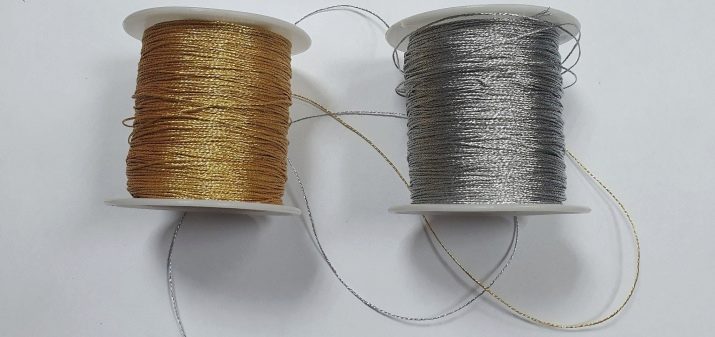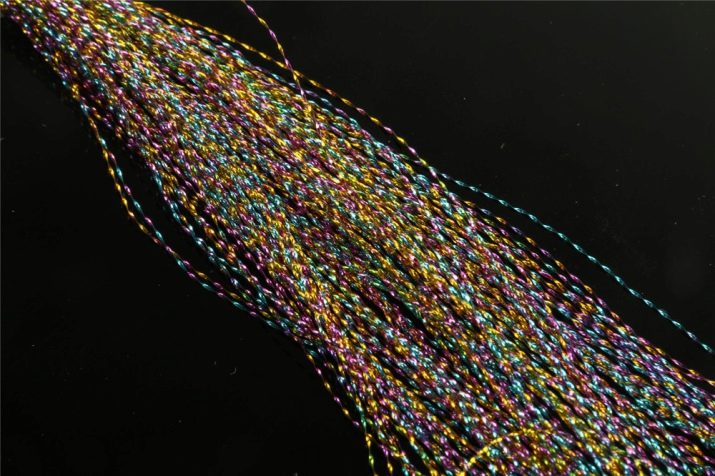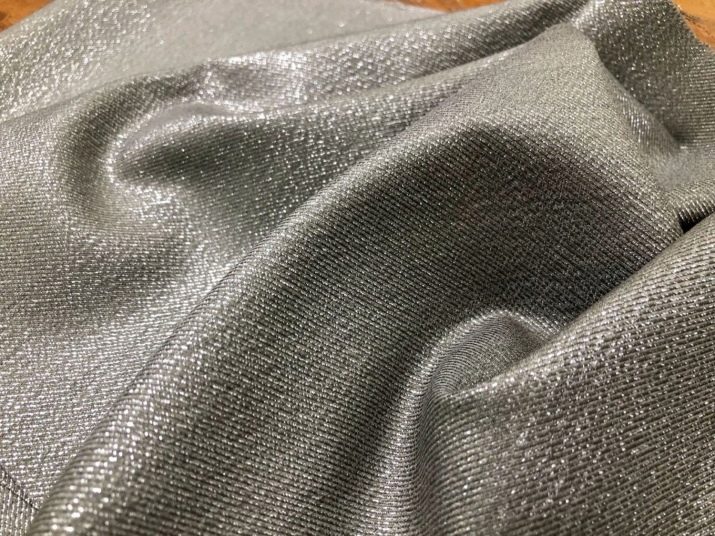What is lurex and how are threads used?

To diversify their image, many women of fashion choose new materials and fabrics. Yarn or fabric with the addition of lurex is in great demand. Despite its popularity, most people don't know what it is or how to care for shiny material.


What it is?
Lurex is considered by many to be one of the many types of fabrics, but it is not. The description states that it is a shiny thread that gives the canvas an exquisite shine and appeal. As a rule, the total number of threads should not exceed 40%, regardless of the type and composition of the textile product.

Lurex thread is not used as the main or independent element.
This material looks great together with basic fibers of different origins. It has long been used to create fashionable clothes, as well as for various canvases, which will be a great addition to the interior. The thread retains its shape remarkably and has excellent strength. It is tough and hard to the touch.


The most common options are gold and silver lurex threads. Cold and warm colors can be successfully combined with the base of different shades. Black material is also found. It is a classic and versatile color that will go well with any garment.

Foil is used as a raw material for the manufacture of lurex, which is made from different metals. It is they who give the thread the main color. Manufacturers choose nickel, aluminum, copper and brass. In addition to metals, dyes can be added to the composition to give the lurex a special color, for example, blue or purple. The coloring pigment is very long-lasting and remains saturated for a long time.
During the manufacturing process, the sheet is covered with a special emulsion. After drying, it forms a reliable protective film on the surface. With its help, the material becomes durable, otherwise the foil will quickly deteriorate. Relatively recently, a new technology has appeared that makes it possible to produce lurex thread from a dense film, and it is dyed with glue. This material has become more wear-resistant compared to its analogue, and the variety of the color palette has increased markedly.
The operational qualities of the material directly depend on the technology of its manufacture. If the threads are made of thin metal, they are distinguished by their high weight and excellent wear resistance, but they are inferior in elasticity to the second type of lurex. The film version is more elastic and lighter, so it is much more convenient to work with it. Thanks to modern developments, the material has turned out to be smoother, more flexible and smoother.

Origin
The material with the bright shine of metals appeared a very long time ago, back in the days of Ancient Egypt. For many centuries, he has been the personification of luxury, sophistication and wealth. In the distant past, gold was used to make lurex, from which thin threads were formed. Then they were woven into fabrics, the appearance of which became more attractive and expressive.

Starting from the 13th century, threads began to be made from a more affordable jewelry metal - silver. To give them the desired color, the material was gilded and woven into silk. Considering the use of precious metals and complex manufacturing technology, only wealthy buyers could afford lurex. Today everyone can buy it.
The availability of the above material is a credit to the American owner of a cigarette packaging company. He came up with the idea to put an aluminum thread in the package to prevent breakage and make it more wear-resistant and stable. After this invention was officially patented, it attracted the attention of textile manufacturers. This is how the modern lurex appeared, which is still very popular today.

The name of the product comes from the word lure, which translates as "attractiveness".
Advantages and disadvantages
Each material has its own advantages and disadvantages. Lurex has a number of positive qualities that depend on the composition of the thread.

Pros of lurex thread:
- high strength and practicality;
- attractive appearance;
- rich shine;
- long service life;
- ease of care;
- relevance that is not lost from season to season;
- multifunctionality;
- the material is not afraid of direct sunlight and mechanical stress.

The following are noted as disadvantages:
- high weight and oxidation (this applies to material made of metal fibers);
- some varieties of lurex are expensive;
- difficulty in work;
- hardness.

Recently, buyers are increasingly choosing polyester material, which is more affordable and more practical to use. And its price is much lower. Due to the fact that the metal thread is more stable, it loses its flexibility and elasticity. The second option (foil lurex) is most often used for making fashion accessories and evening dresses.


What fabrics are added?
Shiny thread can be added to any kind of fabric, whether natural or synthetic fibers. The percentage of its content can be different: from 3 to 30-40%. The more threads in the fabric, the more it will shine.

Lurex is combined with the following types of fabrics.
- Cotton and linen. Natural material, pleasant to the touch, looks great in a duet with shiny thread. To make the fabric pleasant to the body, you need to choose a material with a low content of lurex in the composition. The expressive metallic sheen contrasts with the soft and delicate canvas.

- Polyester. A cheap synthetic fabric that is often used to make bedding, clothing, and other wardrobe items. You can complement the look with a stylish polyester scarf with the addition of shiny threads.

- Viscose. Despite the fact that it is a man-made fabric, it is of natural origin. It is also actively used in the manufacture of men's and women's clothing, and in combination with lurex, viscose becomes more charming and elegant.

- Knitwear. This material is considered one of the most common in the manufacture of clothing for children and adults. When adding dense threads to its structure, you need to use a special technology that will retain the ability of the knitted fabric to stretch. Stylish tight dresses are made from knitwear with lurex for attending evening and special occasions.

Also, yarn is often added to yarn. Such material is in demand both in commercial production and in handicrafts.
The following types of yarn are relevant:
- 100% acrylic (fully synthetic);
- natural yarn made from cotton or animal hair (for example, angora);
- blended, which consists of natural and synthetic raw materials, for example, acrylic and wool 50 to 50% (there are different ratios on sale).



Threads are woven into any of the above options, but most often lurex is found in synthetic and blended yarns.

Answering the question whether the lurex fabric is stretching or not, you need to take into account the weaving option or the composition of the fabric to which the thread was added. Spandex is added to the fibers in order to obtain stretch qualities for the canvases. Otherwise, the material will lose elasticity. Also, the fabric can stretch due to the special structure. These are the properties of jersey.


Application of material with thread
Lurex thread is used to enhance the decorative qualities of the fabric and to influence its practical properties. After adding a material with a metallic sheen, the fabric becomes stronger and more durable. Lurex goes well with light organza. Contrasting materials have always attracted attention due to their unusual appearance. The weightless organza and dense thread complement each other.


The following products can be sewn from lurex-woven material:
- business suits;
- dresses (ceremonial, cocktail, wedding and other models for important events);
- classic shirts and blouses;
- tunics of different lengths;
- jackets;
- stage and carnival costumes;
- hats;
- accessories (scarves, capes, stoles and scarves);
- pillowcases and bedspreads (decorative);
- warm clothes;
- upholstery for upholstered furniture;
- curtains and curtains;
- napkins for festive table setting;
- wallets, clutches, bags, purses;
- outfits for children (costumes for performances);
- fabric hair accessories;
- ties;
- veil.





Care
To preserve the charming appearance of the material and its performance, you need to know the rules for caring for it. Lurex does not respond well to experiments with detergents and temperatures.
Lurex thread is a synthetic material, but it requires careful handling.
When caring for lurex, it is imperative to take into account the composition and properties of the fabric (or yarn) to which it was added. For example, when caring for natural textile products, do not use hot water and hard powder. For wool, linen and cotton, a special mode is provided in washing machines.
For care, we recommend using the delicate cycle in an automatic washing machine. This will save you time and effort. If necessary, the product can be washed by hand. The maximum water temperature should not exceed 30 degrees Celsius.

We recommend that you put your items in a soft laundry bag before loading them into the drum for extra protection. Without it, knitwear or wool products may lose their shape.Mechanical wringing must be abandoned, and after washing, excess water is wrung out manually so as not to damage the structure of the material.
When drying wool, it is advisable to lay things out on a horizontal surface with a towel underneath. In other cases, vertical drying is suitable. Products are hung on hangers away from heating appliances. You also need to protect them from direct sunlight. You can lay out items on the dryer.
Synthetic threads made of plastic can melt during ironing, so you need to use the iron very carefully or refuse it altogether. Ironing is safe only at low temperatures, through gauze, and if the percentage of the thread in the composition does not exceed 3-5. Clean and dry items can be stored folded or hung on a hanger. In any case, the threads will not be damaged.

For cleaning a product with the addition of shining fiber, formulations with aggressive chemical components and abrasive substances, including bleaches, are not suitable. When hand washing, do not twist or rub the material strongly.








